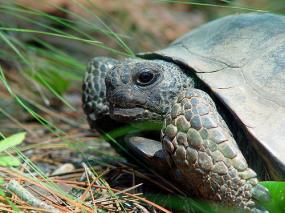
Today, Gartner, in collaboration with Josh Donlan and James Mulligan of Advanced Conservation Strategies, are ready to launch their first pilot transactions.
Here is how the gopher tortoise candidate conservation marketplace is being designed and piloted:
- An interested and eligible private landowner (the “seller”) receives a negotiated payment to conserve, manage, or restore longleaf pine forests capable of supporting healthy populations of gopher tortoises on his or her property. In so doing, the landowner generates gopher tortoise habitat credits.
- The entity paying the landowner (the “buyer”) receives the habitat credits in return. The buyer may use the credits to offset the impact on gopher tortoise habitat elsewhere, in order to meet a voluntary net zero biodiversity impact commitment. Or, the buyer can save the credits for later use to meet offset requirements if the species is listed under the ESA. Other buyers may purchase credits simply to spur gopher tortoise conservation.
- A gopher tortoise habitat credit is the currency that can be bought and sold. The number of credits on a parcel of land is determined via a science-based and peer-reviewed method to ensure a net conservation benefit for the tortoise when used as offsets for future impacts. The credit price includes funds to manage and monitor the habitat, along with a negotiated profit margin for the seller.
- The USFWS approves the crediting methodology and maintains agreements with buyers and sellers. The agency may also provide federal-level assurances to both the buyer and seller. This regulatory certainty allows buyers to preemptively buy credits that can be used toward offsetting future impacts if the species were to be listed.
With 87 percent of southern forests in private ownership, protecting species like the gopher tortoise requires an innovative approach. The gopher tortoise conservation marketplace is testing a new strategy, which provides financial incentives to private landowners who manage their woodlands for habitat and candidate species.
If you would like to learn more about market-based approaches for conservation, such as the approach Gartner began formulating as a PERC Enviropreneur Fellow, then apply to PERC’s Enviropreneur Institute by March 5.


